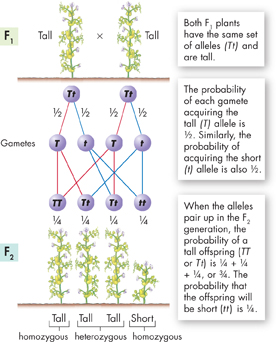Using Segregation to Predict Outcomes The way in which alleles segregate during gamete formation is every bit as random as a coin flip. Therefore, the principles of probability can be used to predict the outcomes of genetic crosses.
Look again at Mendel's F1 cross, shown in Figure 11–7. This cross produced a mixture of tall and short plants. Why were just 1/4 of the offspring short? Well, the F1 plants were both tall. If each plant had one tall allele and one short allele (Tt), and if the alleles segregated as Mendel thought, then 1/2 of the gametes produced by the plants would carry the short allele (t). Yet, the t allele is recessive. The only way to produce a short (tt) plant is for two gametes, each carrying the t allele, to combine.
Like the coin toss, each F2 gamete has a one in two, or 1/2, chance of carrying the t allele. There are two gametes, so the probability of both gametes carrying the t allele is 1/2 × 1/2 = 1/4. In other words, roughly one fourth of the F2 offspring should be short, and the remaining three fourths should be tall. This predicted ratio—3 offspring exhibiting the dominant trait to 1 offspring exhibiting the recessive trait—showed up consistently in Mendel's experiments. For each of his seven crosses, about 3/4 of the plants showed the trait controlled by the dominant allele. About 1/4 showed the trait controlled by the recessive allele. Segregation did occur according to Mendel's model.
As you can see in the F2 generation, not all organisms with the same characteristics have the same combinations of alleles. Both the TT and Tt allele combinations resulted in tall pea plants, but only one of these combinations contains identical alleles. Organisms that have two identical alleles for a particular gene—TT or tt in this example—are said to be homozygous (hoh moh ZY gus). Organisms that have two different alleles for the same gene—such as Tt—are heterozygous (het ur oh ZY gus).

FIGURE 11–7 Segregation and Probability In this cross, the TT and Tt allele combinations produced three tall pea plants, while the tt allele combination produced one short plant. These quantities follow the laws of probability. Predict If you crossed a TT plant with a Tt plant, would the offspring be tall or short?
ddProbabilities Predict Averages Probabilities predict the average outcome of a large number of events. If you flip a coin twice, you are likely to get one heads and one tails. However, you might also get two heads or two tails. To get the expected 50 : 50 ratio, you might have to flip the coin many times. The same is true of genetics.
The larger the number of offspring, the closer the results will be to the predicted values. If an F2 generation contains just three or four offspring, it may not match Mendel's ratios. When an F2 generation contains hundreds or thousands of individuals, the ratios usually come very close to matching predictions.
Table of Contents
- Formulas and Equations
- Applying Formulas and Equations
- Mean, Median, and Mode
- Estimation
- Using Measurements in Calculations
- Effects of Measurement Errors
- Accuracy
- Precision
- Comparing Accuracy and Precision
- Significant Figures
- Calculating With Significant Figures
- Scientific Notation
- Calculating With Scientific Notation
- Dimensional Analysis
- Applying Dimensional Analysis




